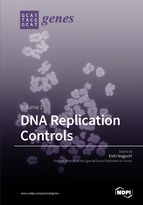DNA Replication Controls
A special issue of Genes (ISSN 2073-4425). This special issue belongs to the section "Molecular Genetics and Genomics".
Deadline for manuscript submissions: closed (15 August 2017) | Viewed by 318911
Special Issue Editor
Interests: genome maintenance; cancer, aging; DNA repair; DNA replication; chromosome instability
Special Issues, Collections and Topics in MDPI journals
Special Issue Information
Dear Colleagues,
The conditions for DNA replication are not ideal, owing to endogenous and exogenous replication stresses that lead to arrest of the replication fork. Arrested forks are among the most serious threats to genomic integrity because they can break or rearrange, leading to genomic instability. Thus, it is important to understand the cellular programs that preserve genomic integrity during DNA replication. Indeed, the most common cancer therapies use agents that block DNA replication or cause DNA damage during replication. Thus, without a precise understanding of the DNA replication program, development of anticancer therapeutics is limited.
In this Special Issue, we welcome reviews, new methods, and original articles covering many aspects of DNA replication controls. These include, but not limited to, regulation of the replisome and its components, DNA replication checkpoints, S-phase stress responses, replication of difficult-to-replication sites, replication of specific genomic loci (such as telomeres and rDNA), translesion synthesis, DNA repair during DNA replication, and other cellular processes that are coordinated with DNA replication. We look forward to your contributions.
Dr. Eishi Noguchi
Guest Editor
Manuscript Submission Information
Manuscripts should be submitted online at www.mdpi.com by registering and logging in to this website. Once you are registered, click here to go to the submission form. Manuscripts can be submitted until the deadline. All submissions that pass pre-check are peer-reviewed. Accepted papers will be published continuously in the journal (as soon as accepted) and will be listed together on the special issue website. Research articles, review articles as well as short communications are invited. For planned papers, a title and short abstract (about 100 words) can be sent to the Editorial Office for announcement on this website.
Submitted manuscripts should not have been published previously, nor be under consideration for publication elsewhere (except conference proceedings papers). All manuscripts are thoroughly refereed through a single-blind peer-review process. A guide for authors and other relevant information for submission of manuscripts is available on the Instructions for Authors page. Genes is an international peer-reviewed open access monthly journal published by MDPI.
Please visit the Instructions for Authors page before submitting a manuscript. The Article Processing Charge (APC) for publication in this open access journal is 2600 CHF (Swiss Francs). Submitted papers should be well formatted and use good English. Authors may use MDPI's English editing service prior to publication or during author revisions.
Keywords
- DNA replication
- DNA repair
- genomic instability
- replication checkpoint
- telomere replication
- replisome
- replication stress
- DNA polymerase
- DNA helicase
- translesion synthesis







